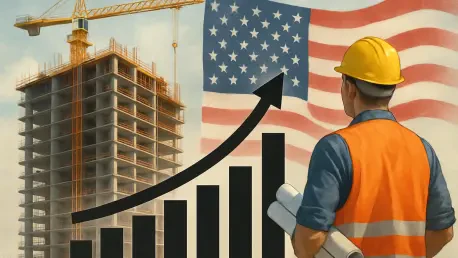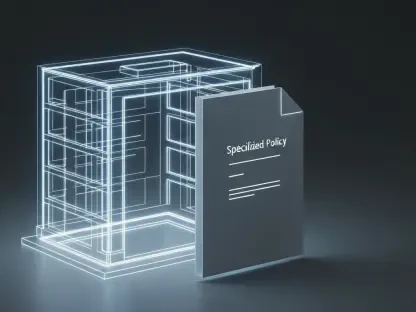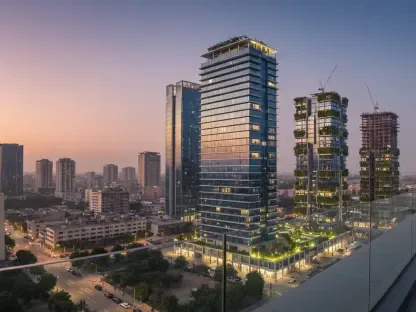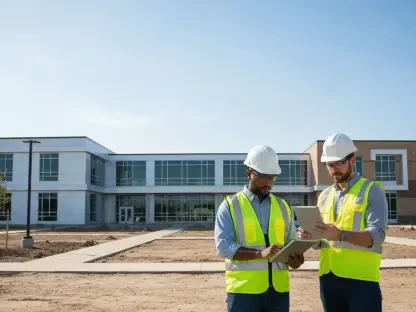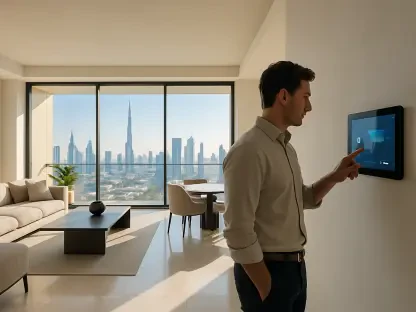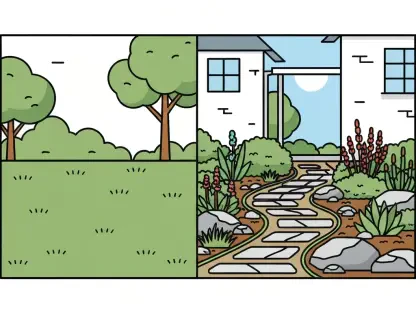The U.S. construction industry is entering a transformative era, with recent projections estimating a staggering market value of $2.92 trillion by 2034, reflecting a robust compound annual growth rate (CAGR) of 4.40% from a 2024 baseline of $1.90 trillion. This remarkable growth trajectory underscores the sector’s critical role in shaping the nation’s economic landscape, driven by a confluence of government-backed infrastructure projects and private sector innovation. From modernizing aging roads and bridges to constructing sustainable commercial spaces, the industry is addressing the pressing needs of a rapidly urbanizing population. This momentum isn’t merely about expanding physical structures; it also signals a shift toward integrating advanced technologies and environmentally conscious practices. As the sector evolves, it promises to redefine how communities are built and sustained, setting a foundation for a future that balances growth with responsibility. The coming decade will test the industry’s ability to navigate challenges while capitalizing on unprecedented opportunities.
Market Growth and Projections
Current State and Future Outlook
The U.S. construction market, valued at $1.90 trillion in 2024, is on a steady path to reach an impressive $2.92 trillion by 2034, driven by a consistent CAGR of 4.40%. This projection highlights the sector’s resilience and its capacity to adapt to evolving economic conditions. Key contributors to this upward trend include substantial investments in public infrastructure and a growing appetite for modernized building solutions. The expansion reflects not just an increase in project volume but also a deeper commitment to quality and efficiency across various construction domains. As urbanization accelerates, the demand for new residential, commercial, and industrial spaces continues to surge, further fueling market growth. This financial outlook serves as a testament to the industry’s pivotal role in supporting national development goals, with significant implications for job creation and economic stability over the forecast period.
Beyond the headline figures, this growth trajectory is underpinned by a complex interplay of policy support and market dynamics. Government initiatives aimed at revitalizing outdated infrastructure are injecting substantial capital into the sector, while private enterprises are stepping up with innovative projects that cater to contemporary needs. The steady CAGR suggests a balanced expansion, avoiding the pitfalls of rapid, unsustainable growth. Notably, the focus on long-term projects, such as transportation networks and energy systems, ensures that the benefits of this expansion will be felt across generations. This forward-looking perspective positions the construction industry as a cornerstone of economic progress, capable of meeting both immediate demands and future challenges with strategic planning and execution.
Drivers of Expansion
A primary engine behind the construction sector’s growth is the unprecedented level of government spending on infrastructure modernization. With aging roads, bridges, and electrical grids in urgent need of upgrades, federal and state policies are channeling billions into projects that enhance connectivity and operational efficiency. These initiatives are not just about repair but also about reimagining infrastructure to support a digital and interconnected economy. The emphasis on public-private partnerships further amplifies this impact, as collaborative efforts ensure that resources are allocated effectively to high-priority areas. This sustained investment is expected to maintain momentum through 2034, providing a stable foundation for market expansion amid fluctuating economic conditions.
Equally significant is the rising demand for sustainable building solutions, which is reshaping project priorities across the industry. Developers and contractors are increasingly focusing on energy-efficient designs and materials that minimize environmental impact, driven by both regulatory requirements and consumer expectations. This shift is particularly evident in urban centers where space constraints necessitate innovative approaches to construction. The integration of green technologies not only addresses ecological concerns but also offers long-term cost savings, making it a compelling proposition for stakeholders. As sustainability becomes a non-negotiable aspect of construction, its influence on market growth is set to deepen, aligning the industry with broader national goals for a greener future.
Industry Trends and Innovations
Technological Advancements
The construction industry is undergoing a technological revolution, with tools like artificial intelligence (AI) and building information modeling (BIM) fundamentally altering how projects are designed and executed. AI-driven analytics enable precise project planning and risk assessment, reducing costly delays and errors. Meanwhile, BIM facilitates seamless collaboration among architects, engineers, and contractors by providing a digital blueprint of structures before ground is even broken. These advancements are not mere conveniences; they represent a paradigm shift toward data-driven decision-making that enhances efficiency at every stage. As adoption rates climb, the potential for cost reduction and quality improvement becomes increasingly evident, positioning technology as a critical enabler of industry progress.
Another transformative force is the integration of 3D printing and Internet of Things (IoT) systems in construction workflows. 3D printing allows for the rapid creation of complex building components, slashing production times and material waste. IoT, on the other hand, powers the development of smart buildings where systems like HVAC, lighting, and security can be controlled remotely for optimal performance. This convergence of technology fosters an environment where projects are completed faster and with greater precision, meeting the stringent demands of modern clients. The ripple effects extend beyond individual projects, as these innovations set new benchmarks for what is achievable, encouraging widespread adoption and continuous improvement across the sector.
Sustainability Focus
Sustainability has emerged as a defining trend in the construction industry, particularly within the commercial sector, where the demand for green buildings is surging. These structures prioritize energy efficiency and eco-friendly materials, aligning with strict regulatory standards and a growing public preference for environmentally responsible development. Developers are investing in certifications like LEED (Leadership in Energy and Environmental Design) to demonstrate their commitment to reducing carbon footprints. This focus not only addresses pressing ecological challenges but also enhances property value and tenant appeal in competitive markets. The push for sustainability is reshaping project planning, as environmental considerations are integrated from the earliest design phases through to completion.
This trend toward green construction is further amplified by national efforts to optimize energy usage and combat climate change. Government incentives and policies are encouraging the adoption of renewable energy sources and sustainable building practices, creating a favorable environment for innovation. In urban areas, where space and resources are often limited, these practices are particularly vital, enabling high-density developments to coexist with environmental goals. The emphasis on sustainability also drives collaboration among stakeholders, as builders, policymakers, and communities work together to balance growth with responsibility. Over the coming years, this commitment is expected to solidify, ensuring that sustainability remains a cornerstone of industry evolution.
Market Segmentation Insights
Construction Types and End-Use Applications
Within the U.S. construction market, additions to existing structures stand out as a dominant segment, reflecting the urgent need to upgrade decades-old infrastructure. This category encompasses expansions and enhancements of buildings, bridges, and other facilities that have outlived their original design capacities. Government initiatives targeting connectivity and operational efficiency are major catalysts, as aging systems are retrofitted to meet modern standards. The focus on additions highlights a pragmatic approach to resource allocation, prioritizing improvements that extend the lifespan of critical assets. This segment’s prominence underscores a broader recognition that sustainable growth often lies in revitalizing the old rather than solely building anew.
Commercial construction, meanwhile, is experiencing rapid growth, fueled by the expansion of private enterprises and retail developments in emerging states. This sector includes office spaces, medical centers, and shopping complexes, where demand is driven by economic activity and population shifts. The integration of green building principles within commercial projects further accelerates this trend, as businesses seek to align with sustainability standards while meeting operational needs. Unlike other end-use categories, commercial construction benefits from a unique blend of private investment and public policy support, creating a robust pipeline of projects. This growth trajectory signals a dynamic future for the segment, with implications for urban development and economic vitality across the nation.
Regional Variations
The U.S. construction market exhibits significant regional disparities, with eight distinct areas—spanning from New England to the Far West—each presenting unique needs and opportunities. In densely populated regions like the Mideast and Southeast, rapid urbanization drives demand for residential and commercial projects, often outpacing supply. Conversely, areas like the Plains and Rocky Mountain regions focus on infrastructure to support agricultural and resource-based economies, with projects centered on transportation and energy systems. These variations reflect differing economic priorities and demographic trends, creating a mosaic of construction activity that defies a one-size-fits-all approach. Understanding these nuances is crucial for stakeholders aiming to tailor strategies to specific regional contexts.
Beyond economic drivers, regional differences are also shaped by environmental and policy factors that influence project feasibility. Coastal areas, for instance, grapple with stricter building codes due to climate risks, necessitating resilient designs that can withstand natural disasters. In contrast, inland regions may prioritize cost-effective solutions to accommodate sprawling development. The diversity in construction needs across these areas highlights the importance of localized expertise and adaptive planning. As growth continues through 2034, regional insights will remain essential for navigating the complex interplay of market forces, ensuring that development aligns with both community needs and broader national objectives.
Competitive Dynamics
Key Players and Strategies
The U.S. construction market is shaped by the influence of major players like Hensel Phelps Construction Company, Lennar Corporation, and Kiewit Corporation, each bringing distinct strengths to the table. Hensel Phelps, with a legacy dating back to 1937, excels in diverse sectors including healthcare and education, leveraging innovation to deliver complex projects. Lennar Corporation, a powerhouse in residential construction since 1954, continues to redefine housing with a broad portfolio of home designs. Kiewit Corporation, established in 1884, dominates large-scale infrastructure, tackling ambitious projects like highways and airports with precision. These companies, through strategic mergers, acquisitions, and expansions, drive competitive standards, pushing the industry toward greater efficiency and excellence in execution.
The strategic maneuvers of these firms often set the tone for market trends, as their investments in technology and talent ripple across the sector. Recent developments, such as expansions into emerging markets and partnerships for sustainable projects, demonstrate a forward-thinking approach to capturing growth opportunities. Their ability to adapt to regulatory changes and client demands further solidifies their market positions, often outpacing smaller competitors. This competitive edge is not just about scale but also about fostering innovation, as these leaders pioneer practices that others emulate. Their influence underscores a market where expertise and vision are as critical as financial resources, shaping a landscape of continuous improvement.
Analytical Frameworks
To navigate the competitive pressures of the construction industry, analytical tools like Porter’s Five Forces and SWOT analyses provide invaluable insights into market dynamics. Porter’s Five Forces examines factors such as supplier power, buyer influence, and the threat of new entrants, revealing how these elements shape strategic decisions. For instance, high barriers to entry due to capital requirements and regulatory complexity often deter new competitors, consolidating power among established firms. Meanwhile, buyer power varies by project type, with government contracts offering stability but demanding stringent compliance. These analyses help stakeholders anticipate shifts in competitive intensity, enabling proactive adjustments to maintain market relevance.
SWOT analysis complements this by dissecting internal strengths and weaknesses alongside external opportunities and threats. Strengths often include robust government support and technological integration, which bolster operational capacity. However, weaknesses like labor shortages and rising material costs pose persistent challenges that require strategic mitigation. Opportunities abound in the growing demand for smart and sustainable buildings, while threats such as economic downturns can disrupt project timelines. Together, these frameworks offer a comprehensive view of the industry’s competitive landscape, equipping firms with the knowledge to capitalize on advantages while addressing vulnerabilities in a rapidly evolving market.
Economic and External Influences
Macroeconomic Context
The construction industry operates within a broader economic framework where indicators like GDP growth, inflation trends, and urbanization rates significantly influence demand. Steady GDP expansion signals a healthy environment for large-scale projects, as both public and private sectors feel confident investing in infrastructure and development. Urbanization, in particular, acts as a powerful driver, with growing city populations necessitating new housing, commercial spaces, and transportation networks. However, inflationary pressures can elevate material and labor costs, squeezing project budgets and timelines. Balancing these economic forces requires a nuanced understanding of how national trends translate into local construction needs, ensuring that growth remains sustainable over the long term.
Additionally, the business climate and associated country risks play a crucial role in shaping industry outcomes. Factors such as public debt levels and policy stability impact the availability of funding for infrastructure initiatives, often dictating the pace of project rollouts. Political risks, including potential regulatory shifts, can introduce uncertainty, affecting long-term planning. Despite these challenges, the construction sector benefits from a generally favorable economic outlook, with urbanization and technological adoption providing counterweights to potential downturns. This interplay of macroeconomic elements underscores the importance of agility, as firms must adapt to external conditions while pursuing ambitious growth targets through 2034.
Path Forward for Industry Stakeholders
Reflecting on the past decade, the U.S. construction industry navigated a complex landscape, achieving a valuation of $1.90 trillion by 2024 and setting the stage for further expansion. Government-driven infrastructure projects tackled critical gaps in connectivity, while technological breakthroughs streamlined operations across countless sites. Sustainability emerged as a guiding principle, with green buildings gaining traction amid regulatory and societal shifts. Major players like Hensel Phelps and Kiewit led with innovation, their strategies shaping a competitive yet collaborative market. Economic trends, from urbanization to inflation, tested resilience but ultimately reinforced the sector’s importance to national progress.
Looking ahead, stakeholders must prioritize strategic investments in technology and workforce development to sustain this momentum. Embracing AI, BIM, and IoT can further enhance efficiency, while training programs address labor shortages with skilled talent. Policymakers should continue fostering public-private partnerships, ensuring funding for infrastructure keeps pace with demand. Sustainability must remain central, with incentives for energy-efficient designs driving long-term value. By aligning with these priorities, the industry can not only achieve its projected growth to $2.92 trillion by 2034 but also build a legacy of innovation and responsibility for future generations.
